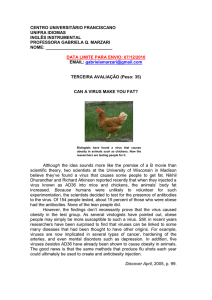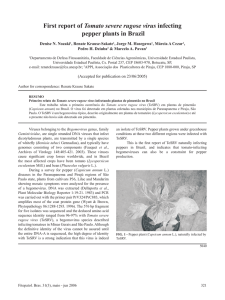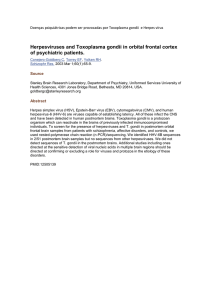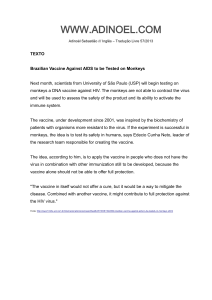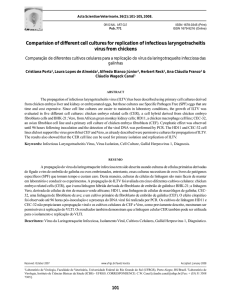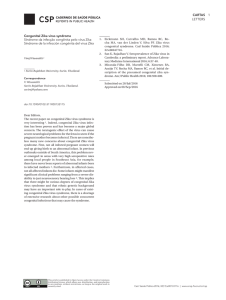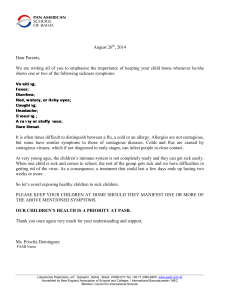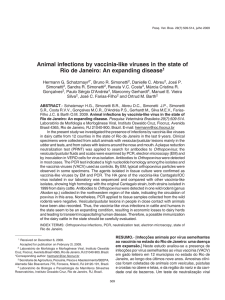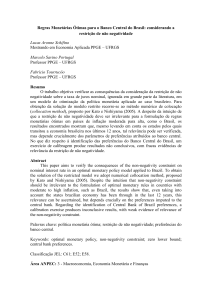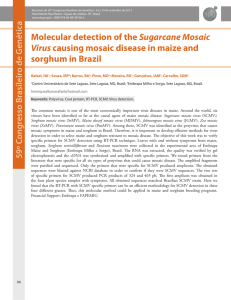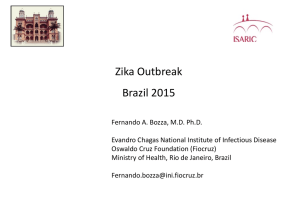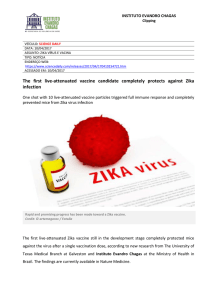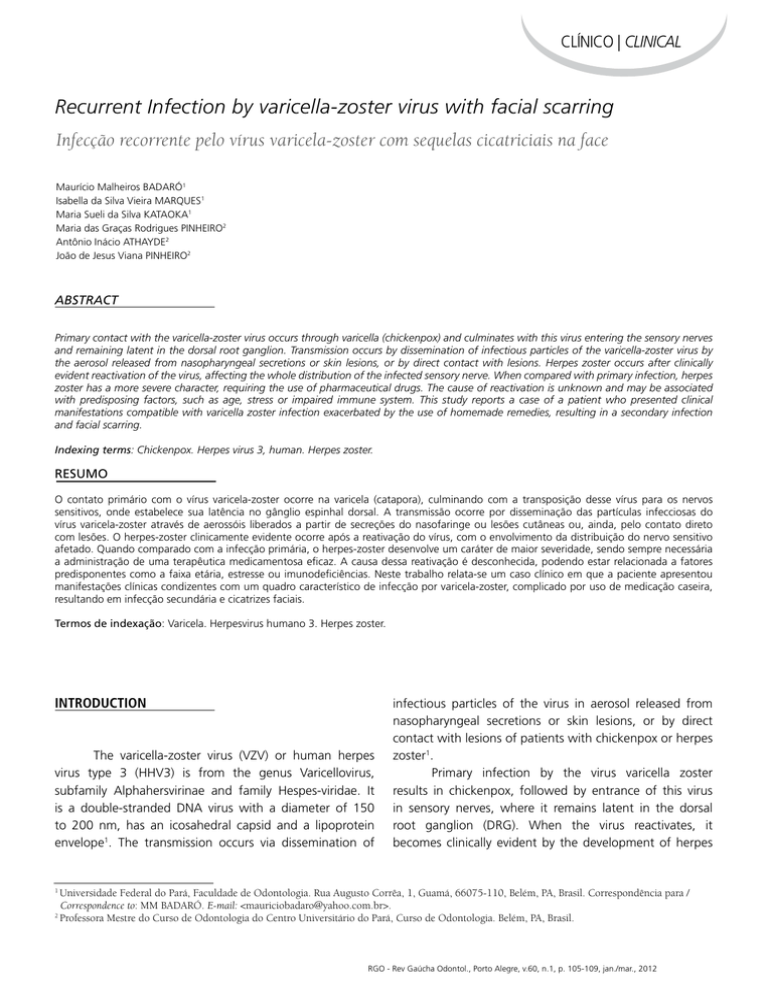
CLÍNICO | CLINICAL
Recurrent Infection by varicella-zoster virus with facial scarring
Infecção recorrente pelo vírus varicela-zoster com sequelas cicatriciais na face
Maurício Malheiros BADARÓ1
Isabella da Silva Vieira MARQUES1
Maria Sueli da Silva KATAOKA1
Maria das Graças Rodrigues PINHEIRO2
Antônio Inácio ATHAYDE2
João de Jesus Viana PINHEIRO2
ABSTRACT
Primary contact with the varicella-zoster virus occurs through varicella (chickenpox) and culminates with this virus entering the sensory nerves
and remaining latent in the dorsal root ganglion. Transmission occurs by dissemination of infectious particles of the varicella-zoster virus by
the aerosol released from nasopharyngeal secretions or skin lesions, or by direct contact with lesions. Herpes zoster occurs after clinically
evident reactivation of the virus, affecting the whole distribution of the infected sensory nerve. When compared with primary infection, herpes
zoster has a more severe character, requiring the use of pharmaceutical drugs. The cause of reactivation is unknown and may be associated
with predisposing factors, such as age, stress or impaired immune system. This study reports a case of a patient who presented clinical
manifestations compatible with varicella zoster infection exacerbated by the use of homemade remedies, resulting in a secondary infection
and facial scarring.
Indexing terms: Chickenpox. Herpes virus 3, human. Herpes zoster.
RESUMO
O contato primário com o vírus varicela-zoster ocorre na varicela (catapora), culminando com a transposição desse vírus para os nervos
sensitivos, onde estabelece sua latência no gânglio espinhal dorsal. A transmissão ocorre por disseminação das partículas infecciosas do
vírus varicela-zoster através de aerossóis liberados a partir de secreções do nasofaringe ou lesões cutâneas ou, ainda, pelo contato direto
com lesões. O herpes-zoster clinicamente evidente ocorre após a reativação do vírus, com o envolvimento da distribuição do nervo sensitivo
afetado. Quando comparado com a infecção primária, o herpes-zoster desenvolve um caráter de maior severidade, sendo sempre necessária
a administração de uma terapêutica medicamentosa eficaz. A causa dessa reativação é desconhecida, podendo estar relacionada a fatores
predisponentes como a faixa etária, estresse ou imunodeficiências. Neste trabalho relata-se um caso clínico em que a paciente apresentou
manifestações clínicas condizentes com um quadro característico de infecção por varicela-zoster, complicado por uso de medicação caseira,
resultando em infecção secundária e cicatrizes faciais.
Termos de indexação: Varicela. Herpesvirus humano 3. Herpes zoster.
INTRODUCTION
The varicella-zoster virus (VZV) or human herpes
virus type 3 (HHV3) is from the genus Varicellovirus,
subfamily Alphahersvirinae and family Hespes-viridae. It
is a double-stranded DNA virus with a diameter of 150
to 200 nm, has an icosahedral capsid and a lipoprotein
envelope1. The transmission occurs via dissemination of
infectious particles of the virus in aerosol released from
nasopharyngeal secretions or skin lesions, or by direct
contact with lesions of patients with chickenpox or herpes
zoster1.
Primary infection by the virus varicella zoster
results in chickenpox, followed by entrance of this virus
in sensory nerves, where it remains latent in the dorsal
root ganglion (DRG). When the virus reactivates, it
becomes clinically evident by the development of herpes
Universidade Federal do Pará, Faculdade de Odontologia. Rua Augusto Corrêa, 1, Guamá, 66075-110, Belém, PA, Brasil. Correspondência para / Correspondence to: MM BADARÓ. E-mail: <[email protected]>.
2
Professora Mestre do Curso de Odontologia do Centro Universitário do Pará, Curso de Odontologia. Belém, PA, Brasil.
1
RGO - Rev Gaúcha Odontol., Porto Alegre, v.60, n.1, p. 105-109, jan./mar., 2012
MM BADARÓ et al.
zoster, commonly known as shingles, and involves the
distribution of the sensory nerve, from the trunk and
head and neck region2-6.
When many branches of the trigeminal nerve are
affected, it may result in unilateral oral, facial or ocular
lesions. The main complications of herpes zoster include:
postherpetic neuralgia, chronic lesions and changes in the
central nervous system (CNS) and eyes4,7-8.
The reason for reactivation of the virus is unknown
and may be related to predisposing factors, such as
age (incidence increases proportionally with age),
stress or immune system impairment stemming from
tumors, acquired immunodeficiency syndrome (AIDS),
autoimmune diseases and use of immunosuppressive
drugs6-11.
The clinical characteristics of herpes zoster may be
divided into three phases: prodromal, acute and chronic.
During initial viral replication, active ganglionitis develops
and results in neural necrosis and severe pain, responsible
for the prodromal symptom of intense pain that precedes
skin eruption in more than 90% of the cases. As the virus
spreads along the nerve, pain worsens and manifests as
burning, perforating, cutting, itching and/or discomfort
on the dermatome, which is the area of the epithelium
supplied by the affected sensory nerve. Before the onset
of mucous and/or skin lesions, the patient may also
experience malaise, headache and fever, in addition to the
prodromal pain2-3.
The acute phase begins when clusters of blisters
with erythematous base appear on the affected skin area.
After some time, these blisters begin to pustulate and
ulcerate. Crusts develop usually 7 days after blister onset,
along the path of the affected sensory nerve, and ends
at the midline. The rash in healthy individuals resolves
within 2 or 3 weeks, leaving hypo- or hyperpigmentation
marks. It is usually necessary and extremely important
to work with a multidisciplinary team. The presence of
lesions on the tip of the nose may indicate involvement
of the nasociliary branch of the trigeminal nerve,
with consequent ocular involvement. In these cases,
intervention by an ophthalmologist is essential2.
The chronic phase is associated with postherpetic
neuralgia, a denomination that refers to the pain
that persists for more than 3 months after the initial
manifestation on the skin. The pain is localized,
continuous, throbbing, stabbing and burning. Most of the
neuralgia subsides within one year2.
106
Shingles vaccine (Zostavax, Merck Sharp and
Dohme, Haarlem, Netherlands) contains live, attenuated
varicella-zoster virus. However, this vaccine is not 100%
efficient. Zostavax contains a higher dosage of the
vaccine virus than the chickenpox vaccine, and the results
are considered good. The vaccine reduces the risk of
developing herpes-zoster by 51%12-14.
The objective of the present study is to report
the clinical case of a female patient aged 28 years who
developed herpes-zoster.
CASE REPORT
A 28-year old woman visited the Integrated
Dental Clinic of the University Center of Pará (CESUPA)
complaining of intense pain, toothache and left facial
swelling (Figure 1). Her medical history included signs and
symptoms of varicella zoster (chickenpox) in childhood.
The patient reported that her initial symptoms were
toothache and intense facial pain, burning and itching.
Later, blisters appeared, which later became ulcers.
The patient applied chicken fat with sulfur on the
affected area. Extraoral signs included facial swelling
with unilateral ulcers, blisters and pustules resulting
from secondary infection, indicating involvement of the
ophthalmic, maxillary and mandibular branches of the
trigeminal nerve (Figure 2). Intraoral signs included white
plaques and ulcers on the left palate, not crossing the
midline, and left buccal mucosa (Figure 3). Based on the
patient’s clinical manifestations and medical history, the
diagnosis was herpes-zoster. The prescribed treatment
included a systemic antiviral drug, Penvir® (Fanciclovir,
Sigma Pharma, Hortolândia, Brazil) at a dosage of two
125mg capsules at 8-hour intervals, a topical antiviral
ointment, Penciclovir (Sigma Pharma, Hortolândia, Brazil),
to be applied on the area at 2-hour intervals, and four
10mg sublingual tablets a day of ketorolac trometamol
to relieve pain. The patient improved significantly
with pharmacological treatment. The oral lesions
disappeared after 80 (eighty) days and did not leave
sequelae. However, although the skin in the affected
area was still healing, it already presented hypo- and
hyperpigmentation marks, probably stemming from the
secondary infection. Facial swelling also resolved (Figure
4).
Before signing the free and informed consent
form, the patient was informed that her pictures would
RGO - Rev Gaúcha Odontol., Porto Alegre, v.60, n.1, p. 105-109, jan./mar., 2012
Recurrent Infection by varicella-zoster
only be used in scientific events and publications, all in
accordance with the ethical principles set forth by the
Declaration of Helsinki (2000).
Figure 3. Intraoral view showing white plaques on the palate and buccal mucosa and extraoral view showing clusters of blisters.
Figure 4. Extraoral and intraoral views of the patient 6 months after the beginning of treatment.
DISCUSSION
Figure 1. Unilateral lesions on the left side of the face and upper and lower lips.
Figure 2. Lateral view of the patient’s face.
The prevalence of varicella-zoster virus reactivation
varies from 10 to 20%. It increases significantly after
age 60 years with children representing less than 5% of
the cases1-2,15. The present case occurred in a 28-yearold patient and so is not in the most affected age group
according to the literature.
The main complaints of the patient were intense
pain on the left side of the face and toothache in the
affected region. The affected tissues were significantly
swollen. These signs and symptoms were compatible with
other published case reports1-3.
Although the disease can be perfectly diagnosed
based on history and clinical picture, a classical ELISA
assay can be used to confirm herpes zoster diagnosis by
determining serum levels of IgG and IgM antibodies. IgG
seroconversion or a significant increase in IgG titer/index
between two paired samples, collected ten days apart,
suggest recent infection16-19. During the medical history,
the patient reported that she had already had chickenpox
and that the present disease began with toothache,
burning, itching and intense pain on the left side of the
face. Later blisters appeared, which then became ulcers,
manifestations described by Neville & Damm2.
RGO - Rev Gaúcha Odontol., Porto Alegre, v.60, n.1, p. 105-109, jan./mar., 2012
107
MM BADARÓ et al.
Many opportunistic infections in human
immunodeficiency virus (HIV)-infected patients are
caused by the herpes group of viruses, presenting in
the primary form or as recurrent herpes, especially in
infected children. These viral infections increase both
HIV dissemination and expression, debilitating the
patient’s immune response11. Therefore, it is important
to determine if the patient with herpes zoster is infected
by HIV. The patient of the present study is not infected
with HIV11, contrary to other clinical cases reported in the
literature5,9.
Involvement of the trigeminal nerve manifests by
the formation of oral lesions in the mobile or attached
mucosa. Often, the lesions extend to the midline and
occur together with skin lesions that cover the affected
quadrant. Oral lesions are white, opaque, range in
diameter from 1 to 4 mm and proceed to form shallow
ulcers. Additionally, teeth in the affected area may
devitalize, there may be significant bone necrosis and
permanent blindness may also ensue1-2. The clinical
picture of the patient consisted of blisters and pustules on
erythematous bases and considerable edema along the
path of the left trigeminal nerve. There were also white
plaques and ulcerations in the left palate and buccal
mucosa, not crossing the midline, which corroborates
other literature reports1-3,20-21. The homemade treatment
used by the patient consisted of topical application of
chicken fat mixed with sulfur. This homemade remedy
hindered the healing process and probably caused the
secondary infection present in the affected region, which
culminated with the formation of fibrous scar tissue.
Initial treatment with appropriate antiviral
drugs accelerates the healing process of the skin and
mucosal lesions and reduces the duration of acute
pain and postherpetic neuralgia. Once the skin lesions
heal, neuralgia may become the worst aspect of the
disease and it is usually hard to resolve it successfully2.
This intense pain is usually treated with systemic and
preferably topical painkillers but there are other methods
available, such as physical medicine, psychotherapy,
occupational therapy and anticonvulsant drugs
(carbamazepine, phenytoin and sodium valproate)4. The
treatment of the present case was based on the literature
and consisted of systemic and topical antiviral drugs
and painkillers. However, topical and systemic antiviral
108
drugs, such as acyclovir and vidarabine, only relieve the
symptoms of existing lesions; they do not exterminate the
virus22.
It is important to point out that the amino acid
L-lysine can significantly reduce herpes simplex virus
1 (HSV1) replication (herpes labialis) and healing time
in animals. However, controlled clinical trials in larger
samples are necessary to confirm its efficiency against
herpes labialis and herpes zoster22.
Finally, it is extremely important to encourage all
health professionals who have a negative or doubtful
history of the disease or negative serology to receive
immunization since, according to the literature, there
has been a case of herpes zoster transmission from a
patient with active lesions to a health provider. Therefore,
occupational risks exist in healthcare facilities, and they
need to be dealt with conscientiously and responsibly.
The entire staff should be tested for varicella-zoster
virus and the facility must have an effective vaccination
program13-14,23-24.
CONCLUSION
The diagnosis of this disease is clinical. Therefore,
the health professional needs to be attentive to its
manifestations to diagnose it early and correctly and
provide appropriate treatment.
Preventive measures should be used to prevent
primary infection by the varicella-zoster virus. This may
be achieved by implementing measures that prevent the
exposure of patients to the virus, passive immunization
(vaccine), active immunization or use of antiviral drugs
after exposure.
When the clinical form of the disease is present,
institution of treatment and patient education are
extremely important to minimize or prevent sequelae,
especially with regard to appropriate healing and
preservation of the affected tissues.
Collaborators
MM BADARÓ, ISV MARQUES and MSS KATAOKA
conceived and helped to write the article. MGR PINHEIRO
and AI ATHAYDE treated the patient and helped to write
the article. JJV PINHEIRO supervised the study and helped
to write the article.
RGO - Rev Gaúcha Odontol., Porto Alegre, v.60, n.1, p. 105-109, jan./mar., 2012
Recurrent Infection by varicella-zoster
REFERENCES
1. Neto LK, Borba MG, Holderbaum RM, Figueiredo MAZ.
Manifestações clínicas e tratamento da infecção recorrente pelo
vírus varicela-zoster: relato de caso clínico. Rev Fac Odontol Univ
Passo Fundo. 2003;8(2):20-3.
2. Neville BW, Damm DD. Patologia oral e maxilo-facial. 2ª ed. Rio
de Janeiro: Guanabara Koogan; 2004.
3. Volkweis MR, Severo AF, Figueiredo MAS, Yurgel LS, Cherubini
K. Herpes-zoster em paciente HIV positivo: relato de caso. Rev
Fac Odontol Univ Passo Fundo. 2003;8(2):24-8.
4. Alvares FK, Siqueira SRDT, Okada M, Teixeira MJ, Siqueira JTT.
Evaluation of the sensation in patients with trigeminal postherpetic neuralgia. J Oral Pathol Med. 2007;36(6):347-50.
5.
Abdul Latheef EN, Pavithran K. Herpes zoster: a clinical study in
205 patients. Indian J Dermatol. 2011;56(5):529-32.
6. Cebrián-Cuenca AM, Díez-Domingo J, San-Martín-Rodríguez
M, Puig-Barberá J, Navarro-Pérez J. Epidemiology and cost
of herpes zoster and postherpetic neuralgia among patients
treated in primary care centres in the Valencian community of
Spain. BMC Infect Dis. 2011;11(1):1-12.
13. Shapiro M, Kvern B, Watson P, Guenther L, McElhaney J, McGeer
A. Update on herpes zoster vaccination: a family practitioner’s
guide. Can Fam Physician. 2011;57(10):1127-31.
14. Oxman MN. Zoster vaccine: current status and future prospects.
Clin Infect Dis. 2010;51(2):197-213.
15. Johnson RW, Dworkin RH. Treatment of herpes-zoster and
postherpetic neuralgia. BMJ. 2003;326:748-50.
16. Costa MRM, Ramos CS, Monteiro TAF. Prevalência de IgG do
vírus varicela-zoster (VVZ) em indígenas da tribo araweté, em
Altamira, Pará, de Janeiro-Fevereiro de 2001. Rev Para Med.
2006;20(4):23-8.
17. Reis AD, Pannuti CS, Souza VAUF. Prevalência de anticorpos para
o vírus da varicela-zoster em adultos jovens de diferentes regiões
climáticas brasileiras. Rev Soc Brás Med Trop. 2003;36(3):31720.
18. Arvin AM, Koropchak CM. Immunoglobulins M and G to varicellazoster virus measured by solid-phase radioimmunoassay:
antibody responses to varicella and herpes zoster infections. J
Clin Microbiol. 1980;12(3):367-74.
7.
Opstelten W, van Loon AM, Schuller M, van Wijck AJ, van Essen
GA, Moons KG, et al. Clinical diagnosis of herpes-zoster in
family practice. Ann Fam Med. 2007;5(4):305-9.
19. Barak M, Weinberger R. Outcome of IgM and Ig G seropositive
cases of varicella zoster in pregnancy. J Reprod Med.
2004;49(1):38-40.
8.
Neves OS, Facó MMM, Sallum AME, Campos LMA, Rossi Júnior
A, Silva CAA. Herpes-zoster em pacientes com lúpus eritematoso
sistêmico juvenil. Rev Bras Reumatol. 2007;47(2):135-9.
20. Alchorne MA, Alchorne AO. Infecções cutâneas virais. In: Cucé
LM, Festa Neto C. Manual de dermatologia. 2ª ed. São Paulo:
Atheneu; 2001. p. 209-11.
9.
Reis HL, Cavalcante FS, Santos KR, Passos MR, Ferreira DC. Herpes
zoster as a sign of AIDS and nonadherence to antiretroviral
therapy: a case report. Clinics. 2011;66(12):2179-81.
21. Silva S, Salomone C. Herpes zóster y neuralgia posherpética. Rev
Chil Dematol. 2005;21(1):38-46.
10. Gonzaga HFS, Jorge MA, Gonzaga LHS, Barbosa CAA, Chaves
MD. Systemic and oral alterations in brazilian patients with
cutaneous herpes-zoster. Braz Dent J. 2002;13(1):49-52.
11. Silva RA, Lopes FF, Barreto AM. Estudo clínico das manifestações
orais da síndrome de imunodeficiência adquirida pediátrica.
RGO - Rev Gaúcha Odontol. 2002;50(1):7-11.
12.Harpaz R, Ortega-Sanchez IR, Seward JF. Prevention of
herpes-zoster: recommendations o the Advisory Committee
on Immunization Practices (ACIP). MMWR Recomm Rep.
2008;57(28):779.
22. Pedrazini MC, Cury PR, Araujo VC, Wassall T. Efeito da lisina na
incidência e duração das lesões de herpes labial recorrente. RGO
- Rev Gaúcha Odontol. 2007;55(1):7-10.
23. Ku CH, Liu YT, Christiani DC. Case report: occupationally related
recurrent varicella (chickenpox) in a hospital nurse. Environ
Health Perspect. 2005;13(10):1373-5.
24. Carvalho ES, Martins RM. Varicela: aspectos clínicos e prevenção.
J Pediat. 1999;75(1):126-34.
Received on: 22/11/2010
Final version resubmitted on: 9/4/2011
Approved on: 28/5/2011
RGO - Rev Gaúcha Odontol., Porto Alegre, v.60, n.1, p. 105-109, jan./mar., 2012
109

